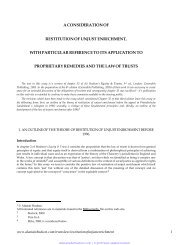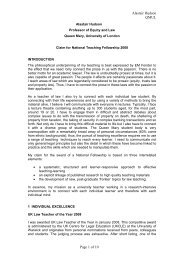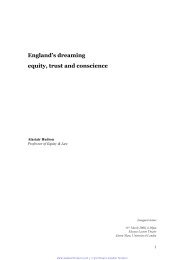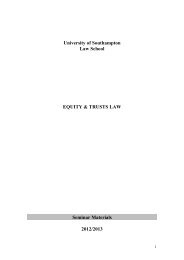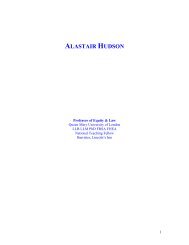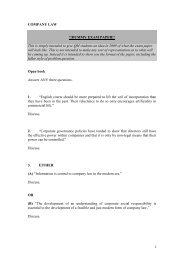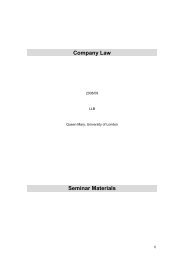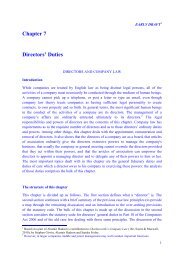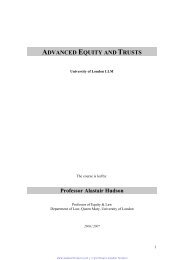The Unbearable Lightness of Property - alastairhudson.com
The Unbearable Lightness of Property - alastairhudson.com
The Unbearable Lightness of Property - alastairhudson.com
Create successful ePaper yourself
Turn your PDF publications into a flip-book with our unique Google optimized e-Paper software.
could not be used by given classes <strong>of</strong> people. 131 In relation to private property they<br />
meant that the use <strong>of</strong> property was reserved entirely to the owner. In relation to civil<br />
code notions <strong>of</strong> dominium, it is easy to see why property law would occupy such a<br />
binary position. However, English property law does recognise a broader spectrum <strong>of</strong><br />
legal relationships as being property rights. That is, it recognises the holder <strong>of</strong> an<br />
easement, the holder <strong>of</strong> an equitable interest and the holder <strong>of</strong> a lease as all having<br />
proprietary rights and not purely personal rights against the holder <strong>of</strong> the legal title.<br />
What this section seeks to explore is the creative aspect <strong>of</strong> property law and its<br />
possible uses as means <strong>of</strong> promoting social solidarity. This requires a conception <strong>of</strong><br />
law as being something which is owned by the people and not simply as something<br />
which is done to them. If law is thought <strong>of</strong> as belonging to the people then it is<br />
possible to think <strong>of</strong> property law as generating a series <strong>of</strong> models <strong>of</strong> behaviour which<br />
enable people to share property. For example, the ability to use trusts to create<br />
charitable purposes <strong>of</strong>fers a model for groups seeking to provide purposes beneficial<br />
to the <strong>com</strong>munity to receive not only the fiscal benefits <strong>of</strong> charitable status but also a<br />
model for the means by which such social activity can be made possible.<br />
Historically, the working class has needed to <strong>com</strong>bine to provide for their <strong>com</strong>mon<br />
security in parallel with the ways in which the propertied classes were concerned to<br />
<strong>com</strong>bine to increase their wealth. For the working classes the units which they used<br />
were what would now be termed unincorporated associations, in the form <strong>of</strong> friendly<br />
societies or industrial and provident societies. At the time they were first created there<br />
was no term <strong>of</strong> art to describe them. From the late eighteenth century, co-operative<br />
movements were formed in England. 132 <strong>The</strong>y were considered seditious and so were<br />
illegal until the late nineteenth century with their decriminalisation in 1874. It was<br />
thought to be dangerous for the working classes to <strong>com</strong>bine because it might enable<br />
them to form rebellious groups and so the Combination Acts were passed to<br />
criminalise such associations. Over time, in the white heat <strong>of</strong> the industrial revolution<br />
and at the height <strong>of</strong> Victorian enthusiasm for imperial capitalism, the justifications for<br />
the criminalisation <strong>of</strong> such associations, and subsequently for making them liable in<br />
tort for any loss they caused to employers, were economic rather than to do with<br />
public order.<br />
What such associations sought to achieve was a measure <strong>of</strong> security for their<br />
membership against loss <strong>of</strong> in<strong>com</strong>e through illness, infirmity or otherwise. <strong>The</strong><br />
Victorians saw the benefits in enabling the working classes to maintain the available<br />
pool <strong>of</strong> labour and in reducing the pressure on the workhouses by allowing such<br />
associations to spring up organically, or to be formed by the Gradgrinds 133 <strong>of</strong> local<br />
<strong>com</strong>munities to ensure the proper behaviour <strong>of</strong> the proletariat.<br />
131 Cotterrell, Emile Durkheim: law in a moral domain, Edinburgh UP, 1999, 94.<br />
132 Identifying the first such organisation is all but impossible. E.P Thompson rejects the <strong>com</strong>mon<br />
assertion that the first working class political association was the London Corresponding Society in<br />
1792; see Thompson, <strong>The</strong> making <strong>of</strong> the English working class, Penguin, 1968, 22. <strong>The</strong> beginnings <strong>of</strong><br />
widespread working class <strong>com</strong>bination are placed at the time <strong>of</strong> the “American war” in the late<br />
eighteenth century: ibid., 22. <strong>The</strong>re is evidence that rudimentary groups <strong>of</strong> labourers or tradesmen had<br />
been formed in secret (due to the laws on sedition) as early as the 1670’s: ibid., 28.<br />
133 Cf. Dickens, Hard Times.<br />
34



